This article may contain affiliate/compensated links. For full information, please see our disclaimer here.
At 5:30 am each morning, hundreds of monks leave their respective temples. Bare feet padding softly on the sidewalks, they are in a walking meditation. Traversing the streets of Luang Prabang in long, straight lines, carrying their heavy alms bowls over one shoulder, it is time for the daily almsgiving.
Local Buddhists wait in front of their homes and shops to offer them sticky rice. These local people wake up in the wee hours of the morning to prepare the rice and ensure it is fresh and clean from impurities, both physical and spiritual.
With shoulders and knees covered, scarves wrapped around their waists and one shoulder in the traditional style, the local people kneel or sit on low stools. They make sure to stay below the monks at all times as a sign of respect. Pinching a golfball sized amount of warm sticky rice from their bamboo baskets and rolling it in their fingers to form a ball, the supplicants drop one into each monk’s bowl. They repeat this over and over as long lines of monks walk past, bowing their heads and lowering their eyes respectfully each time.
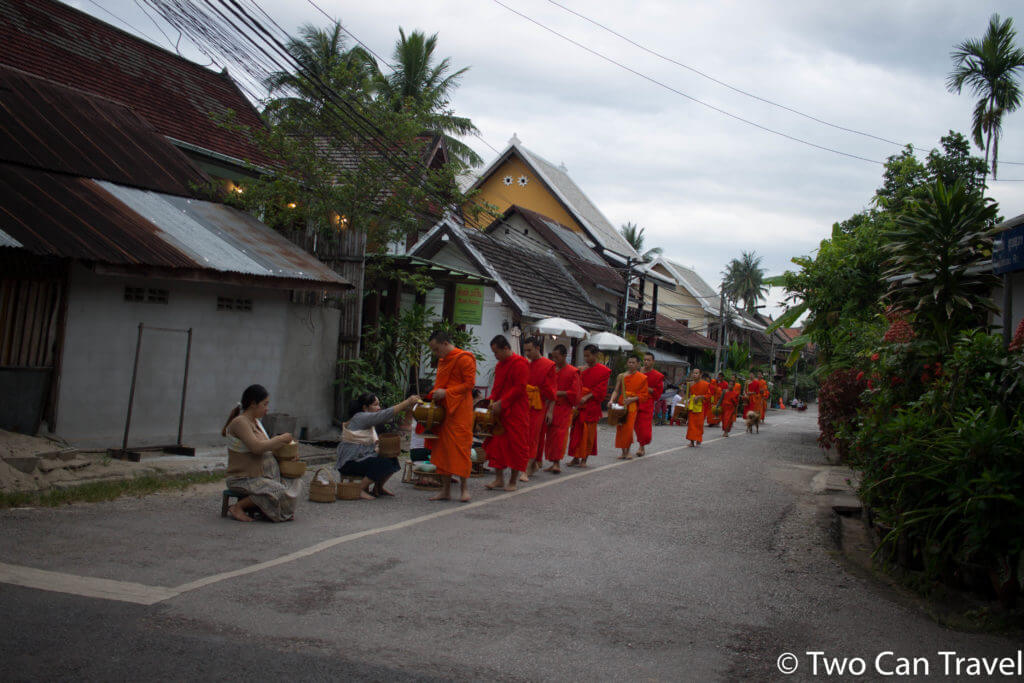
Luang Prabang locals giving sticky rice to monks on a much quieter street in town.
This daily religious ceremony has gone on for centuries. This is how local people pay respect to the monks and make merit for their families. It is an important and meaningful part of Luang Prabang’s Buddhist cultural.
For decades travelers coming to Luang Prabang have woken up before the sunrise and admired this daily tradition.
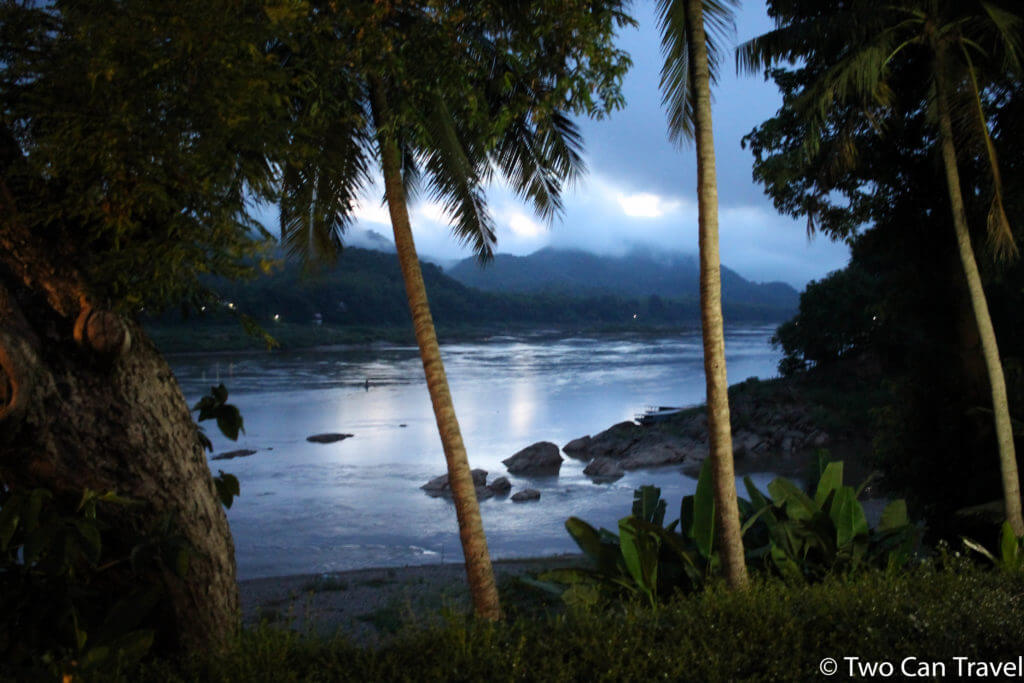
Sunrise over the Mekong River before the Tak Bat alms ceremony in Luang Prabang.
It is hard not to be wowed by the sight of hundreds of monks in bright saffron robes walking past centuries old temples. an image from National Geographic popping straight off the page.
In 1995 Luang Prabang was declared a UNESCO World Heritage Site, giving it protected status to preserve its beautiful culture, architecture, and history. This put it on the map for millions of people around the world who have since visited to experience all that the city has to offer. One of those experiences, of course, is witnessing the Tak Bat ceremony.
Capitalizing on this tourism boom, enterprising locals now set up low stools along the main road in town. Each morning local women stand at tables in the middle of the road selling baskets of sticky rice and packages of snack foods to tourists who want to partake in the ceremony.
The rice they sell is often old and crunchy. And of course, the cakes and instant noodles are a far cry from the purpose of offering nourishing, thoughtfully prepared food that will power the monks through their day, as they stop eating at noon.
What I witnessed when I attended the ceremony was in all honesty shocking. June is considered part of the “low season” in Laos. However, there were still hundreds of tourists along the main road. A majority were from Thailand and China, but there were people from all over the world. Many took part in the ceremony, but clearly at varying levels of understanding.
A group of men sat waiting on stools along the road with baskets of sticky rice, then stood up as the monks approached, towering over them as they dropped gobs of rice into the alms bowls.
The monks pass by quickly, and I saw one person drop a bit of rice on the ground then quickly pick it up and put it into a monk’s alms bowl. Another person put in loose money which is not traditionally done. Not to mention it’s not clean to mix money with food!
It is believed that what you give now to the monks is what you will receive in the afterlife. And nobody wants to eat food that has been dropped on the floor or touched money!
So much food is given to the monks on this busy road that they end up donating a lot of it. You can see the monks pass by the tourists, then moments later drop some of the packaged foods into baskets which will be taken to nearby villages. A lot of the food sold to tourists comes via women from those same villages, and thus it is a daily cycle of buying and selling the same packaged foods.
I visited Luang Prabang in June 2017 for the Mekong Tourism Forum as part of the Media. We were invited to join the Tak Bat ceremony. Afterwards, we had breakfast with a Senior and Novice Monk to discuss the experience and ask questions.
The Senior monk said that he does not mind tourists taking part in the ceremony. However, there are some things people need to keep in mind before they observe the ceremony or join in. I have summarized his points below.
Observing the Tak Bat Ceremony
- If you want to take photos, keep a good distance of at least a few meters while doing so. Most cameras have zoom features, so please use them.
- Do not use flash photography. Especially in the cold season when the morning is dark and misty, the flash is disturbing for the monks.
- Do not stand in the path of the monks. Many people taking photos these days stand directly in front of the monks, blocking their path and forcing them to walk down on to the street to go around.
- Talk quietly or not at all.
- If you see others being disrespectful in these ways, gently and kindly ask them to stop.
Joining the Tak Bat Ceremony
- Only choose to take part in the ceremony if it has meaning to you. Even non-Buddhist can take part in Buddhist ceremonies, that is part of the beauty and openness of Buddhism. BUT don’t just do it for the pictures.
- Dress respectfully. Cover your shoulders and knees. Take off your shoes. Wear a scarf around your waist and shoulders the way the locals do.
- Purchase rice from your hotel or guest house. NOT on the street to ensure that is it fresh. You can request this the night before.
- If you do give money, put it in a clean plastic bag so it will not contaminate the food.
- Do not give heavy things like water bottles. The monks have to carry their alms bowls for a long time and this will make them tired.
- Stay seated or kneeling below the monks. Bow your head and lower your eyes slightly as you drop the rice into the bowl.
- Women should take care not to touch the monks.
- Educate yourself about the ceremony before going. The German Federal Enterprise for International Cooperation (GIZ) has put together this fantastic video following a Novice Monk through his day and to the Tak Bat ceremony.
Watch this video to learn more about the Tak Bat alms-giving ceremony.
Thank you for reading!
If you found this article useful, please share it. Help spread the word about responsibly attending the Tak Bat ceremony in Luang Prabang. It is important to educate ourselves on how we can properly respect the cultures we are welcomed into when we travel.
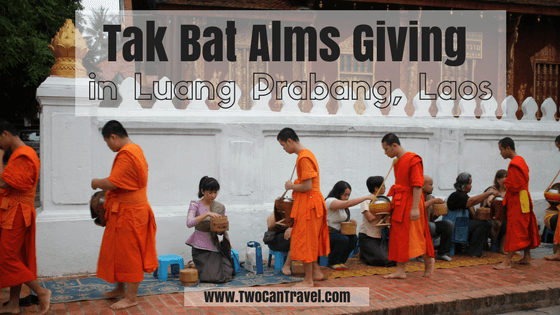
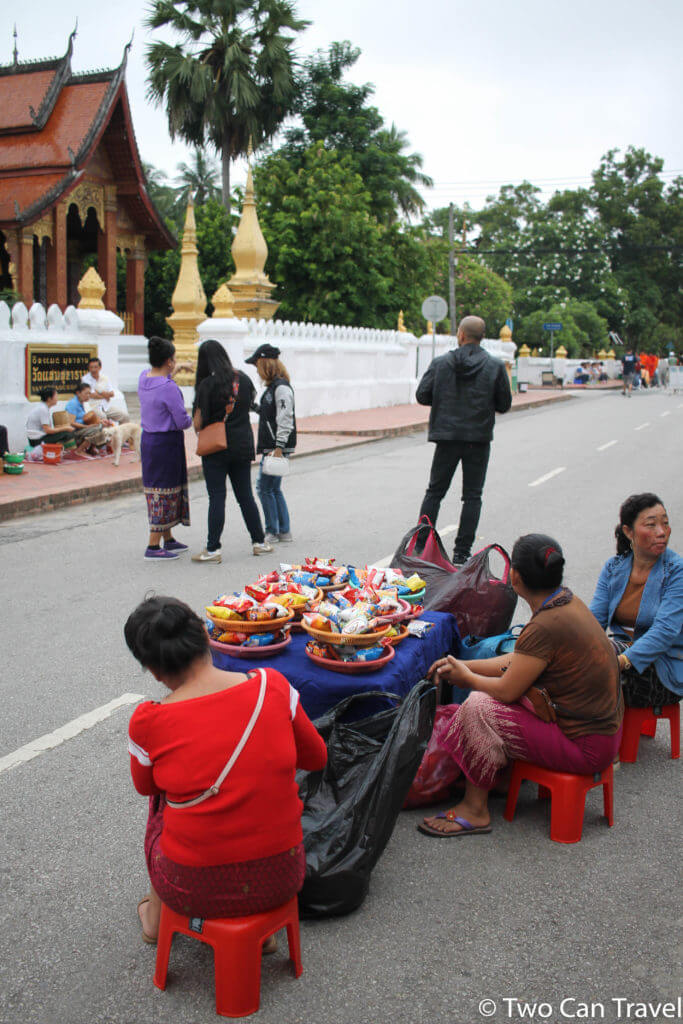
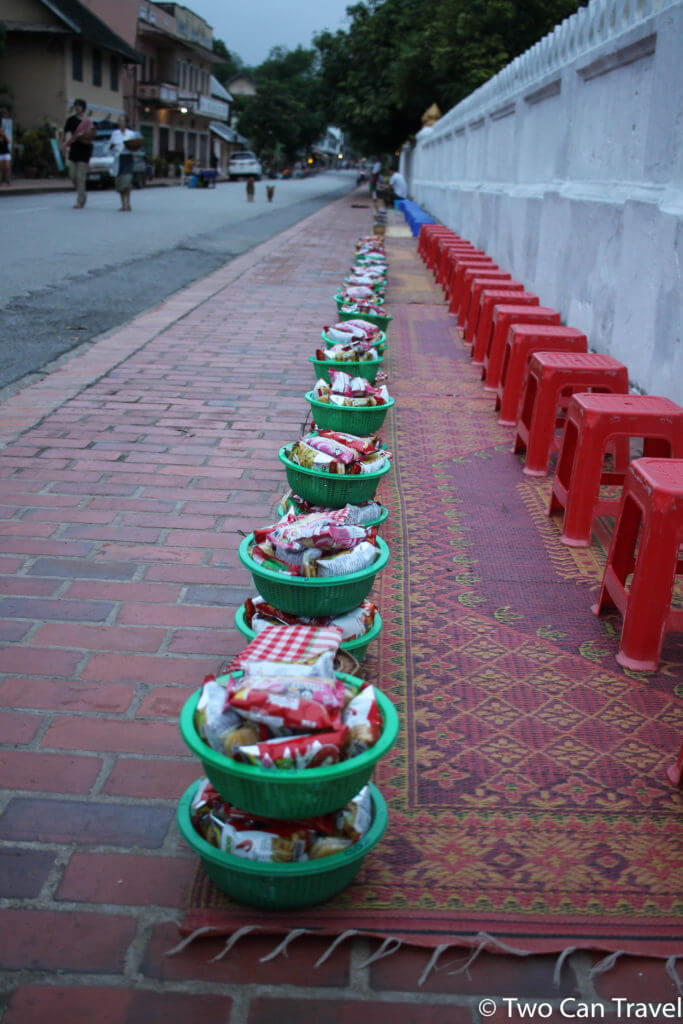
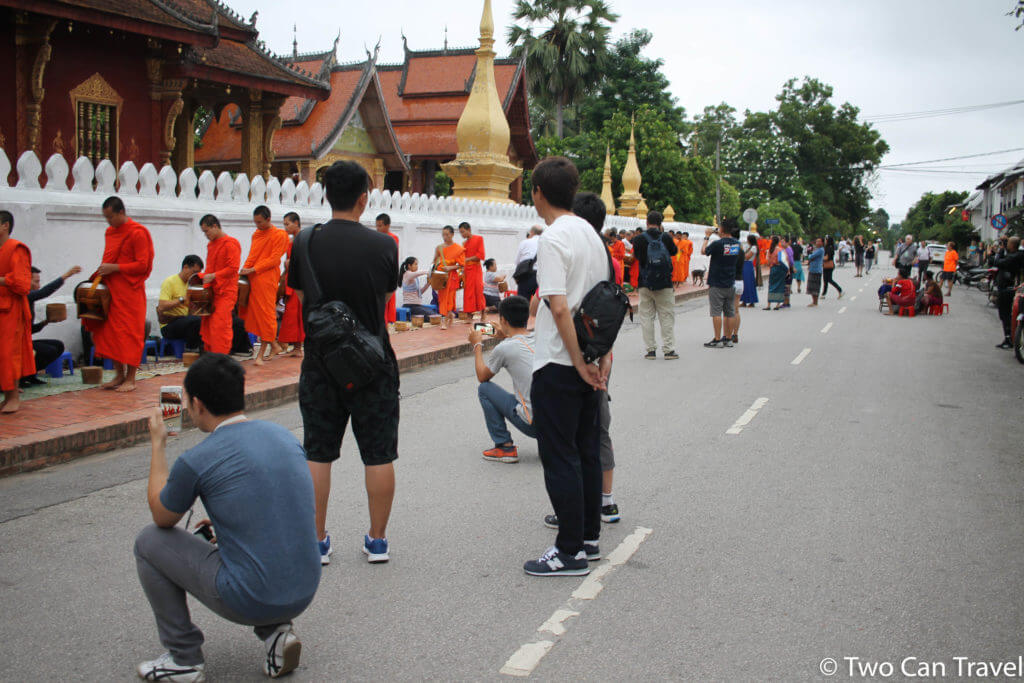
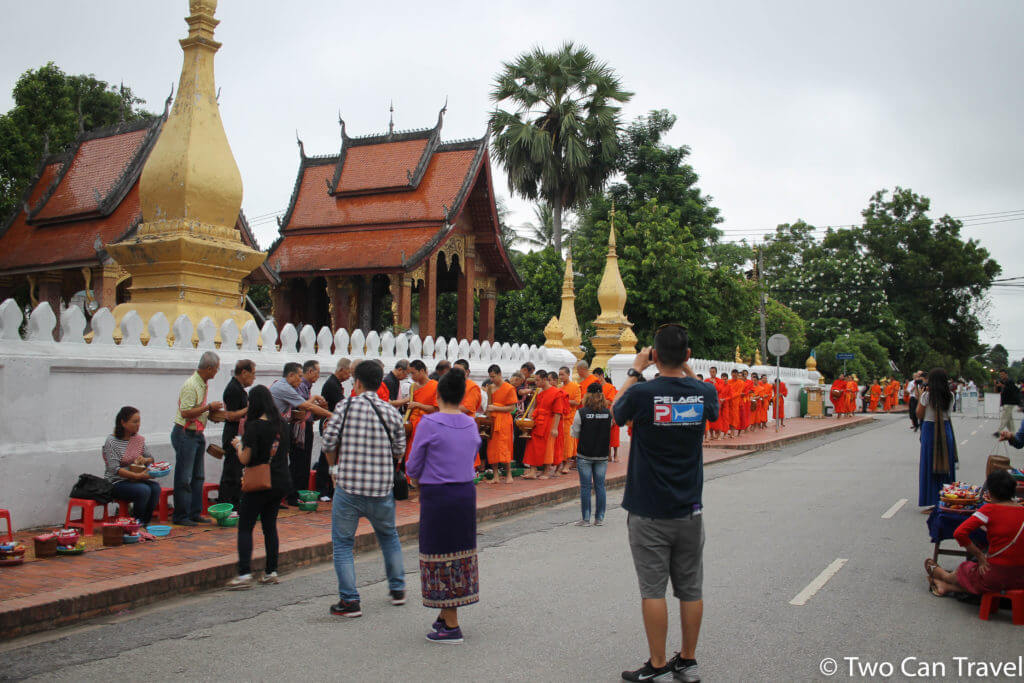
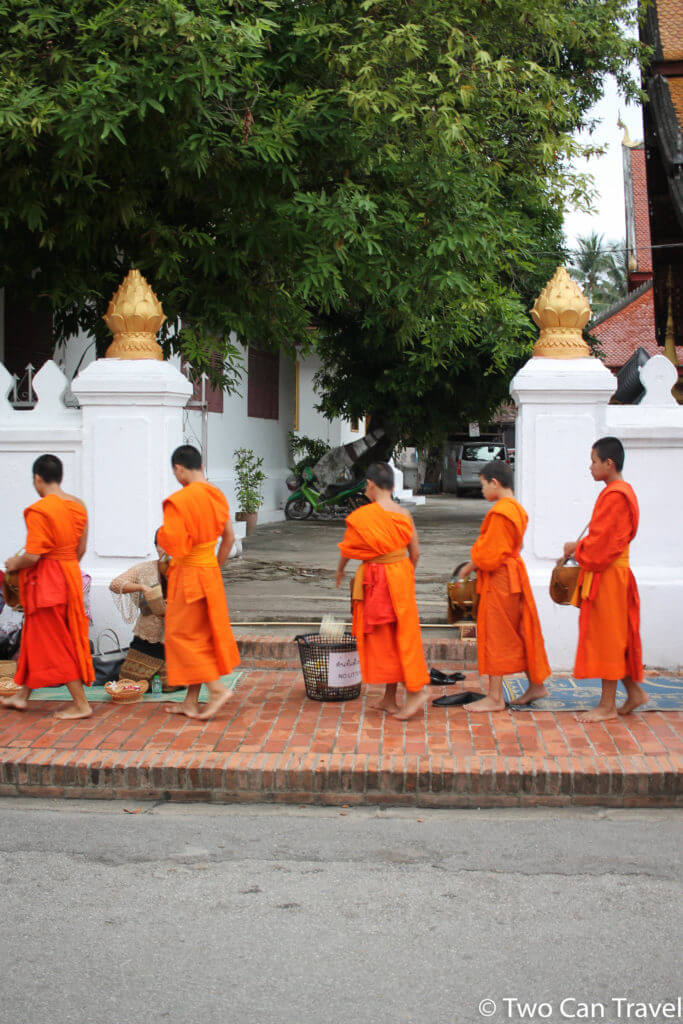
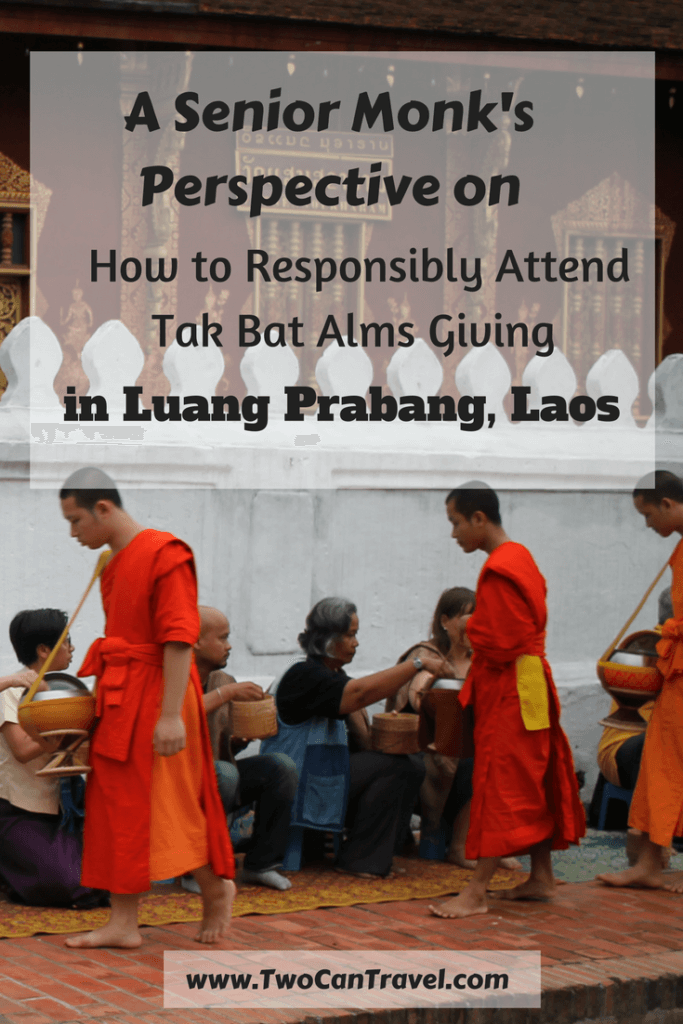
Lovely photos, a nice way to capture the moment and not too close up to disrupt! Well done
-Steve
Hey Jen I just saw this article that you wrote. Thank you a lot for writing it and showing the video!
Hey Radium! Thank you and GIZ for your time and sharing such important information with us all! Hope you’re well 🙂
Seriously it would never have occurred to me to partake in a local – especially religious – custom without invitation and without understanding. I mean, not everything local is infused with meaning, sure, but those that are, are often special and specific. I do mean to visit Luang Prabang, as it’s in my own ASEAN region.
However, it is better to focus on educating people’s hearts, and hope that the behaviour shifts accordingly. In an increasingly unmindful world, it is important to re-teach the decorum of the heart. I will share this.
Thanks for your comment, Nuraini, and for sharing. I agree, if there isn’t a spiritual reason or understanding of the tradition, then it’s probably best to just observe.
Wow, I really enjoyed reading this article. So informative, too. I had no idea the details of the Tak Bat ceremony, and I am sad that it has been rather tainted by allowing tourists to join in when they are not knowledgeable about it. I hope the alms ceremony can remain pure.
We loved witnessing the alms giving in Luang Prabang, and even got up a few times to witness it again and again! It’s just one of those amazing experiences that really fulfils us!
Thanks for sharing this information on the Tak Bat ceremony in Luang Prabang. I was in Laos last year and wanted to attend the alms ceremony in Luang Prabang, but I decided not to go after researching the recent developments. It is too bad that travellers can’t be more respectful.
The alms giving ceremony is so solemn and serene. The monks give the locals an opportunity to serve them and I am sure the locals derive great bliss and contentment in the act of cooking the rice and giving it to the monks. This practice is also common in monks in Hinduism.
Alms ritual is common among the Buddhists. If I remember right, they are not supposed to eat unless it has been donated to them. I saw a similar ‘event’ in Thailand where the monks came in boats to accept alms.
I have never heard of this ceremony so it is eye-opening for me. A great reminder on being respectful when taking part in it. Thanks for sharing your experience!
I’ve heard of this ritual in Laos and have seen many photos, but I had no idea it had become such a tourist event. It’s sad that such a long standing cultural and spiritual event has been marred by tourists who couldn’t spend 5 minutes researching what to do during the ceremony. I’m glad this tradition is still going though, and hopefully the visitors will become a little more respective over time.
Wow! This is such a sweet ritual. I love how other countries are so thankful for family. It is something that I respect about many countries of the world. America sure doesn’t do that
It’s the curse of the World Heritage Site isn’t it. It’s one of tourism’s biggest tragedies, when our presence dilutes culture and starts to damage the very reason we’re visiting in the first place. I would love to visit and witness the Alms, as this is a tradition I’ve read much about. Thankyou for including tips on how we can respectfully witness and take part – I hope tourism doesn’t become too much of a burden on Luang Prabang.
What a wonderful documentation. I saw nuns in pink robes in Yangon Scott’s market singing for alms and this reminded me of that. The young nuns were so innocent. I followed them wherever they went and tried to learn about the process from local shops. Reading this took me back there. Thanks for sharing this. A unique exploration!
I visited Luang Prabang a few years ago and loved how chilled out this place it. Never got a chance to speak to a monk though, an amazing experience it seems!
As you say, this looks as if it has come straight from National Geographical. I love the Buddhist religion – so peaceful
This is such an interesting read. I have always been interested in this area and traditions. Plus photos of monk schools, temples or anything else always turns out beautiful. However I somehow always feel uncomfortable taking photos of them, betcause it seems disturbing for them in a way. So I agree with your photography tips. I’m really happy I got to read this great post!
This sounds like an interesting experience. I’m glad you’ve shared your tips and made us aware of the correct way to behave when visiting. Great post 🙂
What a beautiful and serene spot. I find the colour of the monks’ orange robes rather soothing. I’m sure there was a special energy in the air. It sounds like festival time would be the best time to go.